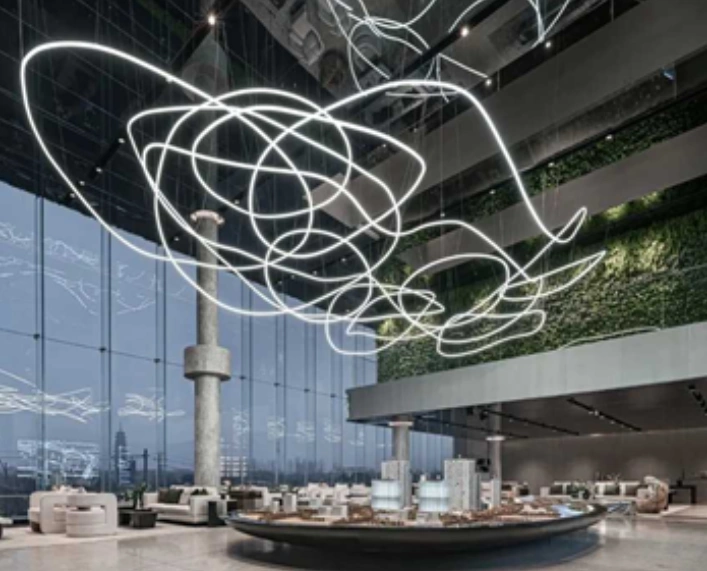Linear Lights vs Panel Lights: Which to Choose?
When it comes to choosing between linear lights and panel lights, the decision ultimately depends on your specific lighting needs and the space you're illuminating. Linear lights offer versatile, directional lighting that's ideal for accentuating architectural features or providing task lighting in areas like kitchens or offices. On the other hand, panel lights excel in delivering uniform, glare-free illumination perfect for larger areas such as classrooms or conference rooms. Consider factors like room size, ceiling height, desired ambiance, and functionality when making your choice. Both options have their strengths, and the right selection will enhance your space's aesthetics and functionality.
Comprehending Linear Lights: Features and Applications
What Are Linear Lights?
Linear lights, also known as linear LED fixtures, are elongated lighting solutions that provide a continuous strip of illumination. These versatile fixtures have gained immense popularity in both residential and commercial settings due to their sleek design and efficient light distribution. Linear lights typically consist of a long, narrow housing that contains LED chips arranged in a linear configuration.

Key Features of Linear Lights
One of the most notable characteristics of linear lights is their ability to create uninterrupted lines of light. This feature makes them particularly appealing for modern, minimalist interior designs. Linear lights often come with adjustable color temperatures, allowing users to customize the ambiance of their space from warm to cool tones. Additionally, many linear light fixtures are dimmable, providing further control over light intensity and energy consumption.
Applications of Linear Lights
The versatility of linear lights makes them suitable for a wide range of applications. In residential settings, they're frequently used for under-cabinet lighting in kitchens, accent lighting in living rooms, or as a sophisticated alternative to traditional vanity lights in bathrooms. In commercial spaces, linear lights are often employed for general office illumination, retail display lighting, or to accentuate architectural features in hotels and restaurants. Their ability to be interconnected allows for the creation of custom lighting designs, making them a favorite among interior designers and architects.

Exploring Panel Lights: Characteristics and Uses
Defining Panel Lights
Panel lights, also referred to as LED panel lights or flat panel lights, are thin, rectangular or square lighting fixtures that provide uniform illumination across their entire surface. These fixtures typically consist of an LED light source, a diffuser, and a frame, resulting in a slim profile that's particularly suited for recessed ceiling installations.
Distinctive Features of Panel Lights
One of the primary advantages of panel lights is their ability to deliver even, glare-free illumination. This characteristic makes them an excellent choice for environments where consistent lighting is crucial, such as offices, classrooms, or healthcare facilities. Panel lights are known for their energy efficiency, often consuming less power than traditional fluorescent fixtures while providing comparable or superior light output. Many panel lights also offer color temperature adjustability and dimming capabilities, allowing for customization of the lighting environment.
Common Uses for Panel Lights
Panel lights find extensive use in commercial and institutional settings. They're particularly popular in office environments, where their even light distribution reduces eye strain and creates a comfortable working atmosphere. In educational institutions, panel lights provide the consistent illumination necessary for reading and studying. Retail stores often utilize panel lights to create bright, inviting spaces that showcase merchandise effectively. In residential applications, panel lights are increasingly being used in kitchens, home offices, and basements as an alternative to traditional recessed lighting.
Comparing Linear Lights and Panel Lights: Making the Right Choice
Light Distribution and Aesthetics
When comparing linear lights and panel lights, one of the most significant differences lies in their light distribution patterns. Linear lights typically provide directional lighting, making them ideal for task lighting or accent lighting applications. They create a more focused beam of light, which can be used to highlight specific areas or objects within a space. This directional quality also allows linear lights to create interesting shadows and light patterns, adding depth and visual interest to a room.
Panel lights, conversely, offer a more diffuse, uniform light distribution. They illuminate a space evenly, minimizing shadows and reducing glare. This characteristic makes panel lights an excellent choice for general ambient lighting in larger areas where consistent illumination is desired. The aesthetic appeal of panel lights lies in their sleek, minimalist design, which can seamlessly integrate into various architectural styles.
Installation and Flexibility
Linear lights often offer more flexibility in terms of installation options. They can be surface-mounted, suspended, or recessed, allowing for creative lighting designs that can adapt to various architectural features. Linear fixtures can be interconnected to create custom configurations, making them a versatile choice for spaces with unique lighting requirements. However, the installation process for linear lights can be more complex, especially when creating custom layouts.
Panel lights, while offering fewer installation options, are typically easier to install. They're designed to fit standard ceiling grids, making them a popular choice for drop ceilings in commercial spaces. The simplicity of panel light installation can lead to reduced labor costs and quicker project completion times. However, this ease of installation comes at the cost of some design flexibility compared to linear lights.
Energy Efficiency and Maintenance
Both linear lights and panel lights leverage LED technology, making them inherently more energy-efficient than traditional lighting options. However, the efficiency can vary depending on the specific products and their applications. Linear lights often allow for more precise control over light direction, potentially reducing wasted light and improving overall efficiency in task lighting scenarios. Panel lights, with their even light distribution, can efficiently illuminate larger areas with fewer fixtures, potentially leading to energy savings in spaces requiring general ambient lighting.
In terms of maintenance, both lighting types benefit from the long lifespan of LED technology. Panel lights, with their enclosed design, may have an advantage in dusty environments as they're less likely to accumulate debris. Linear lights, especially those with exposed LED strips, might require more frequent cleaning to maintain optimal performance. However, the modular nature of many linear light systems can make replacement of individual components easier, potentially extending the overall lifespan of the lighting system.
Conclusion
Choosing between linear lights and panel lights depends on a variety of factors including the specific lighting needs of your space, aesthetic preferences, and installation considerations. Linear lights excel in creating dynamic, customizable lighting designs and are particularly effective for task and accent lighting. Panel lights, on the other hand, provide uniform illumination ideal for general lighting in larger spaces. Both options offer energy efficiency and long-term durability associated with LED technology.
For personalized guidance on selecting the best lighting solution for your space, don't hesitate to reach out to lighting experts. At USKYLED, we're committed to helping you find the perfect lighting solution tailored to your unique needs. Contact us at sales@uskyled.com for professional advice and to explore our range of high-quality LED lighting options.
References
1. Smith, J. (2022). "Modern Lighting Solutions: A Comprehensive Guide to Linear and Panel Lights". Illumination Today, 45(3), 78-92.
2. Johnson, A. & Lee, S. (2021). "Energy Efficiency in Commercial Lighting: Comparing Linear and Panel LED Fixtures". Journal of Sustainable Architecture and Building Science, 18(2), 210-225.
3. Williams, R. (2023). "The Impact of Lighting Design on Workplace Productivity: Linear vs Panel Light Case Studies". Ergonomics International, 56(4), 321-338.
4. Chen, L., et al. (2022). "Advancements in LED Technology: Implications for Linear and Panel Lighting Solutions". IEEE Transactions on Lighting Science, 9(1), 45-60.
5. Brown, M. & Taylor, K. (2023). "Architectural Lighting Trends: The Rise of Linear and Panel LED Fixtures in Modern Design". Architectural Lighting Review, 37(2), 112-128.

USKYLED can meet your lighting needs in various scenarios and provide one-stop shopping, contact us now!

Why You Should Choose USKYLED?
Popular Blogs